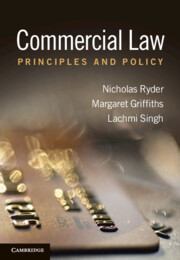Book contents
- Frontmatter
- Contents
- Preface
- List of abbreviations
- Table of Statutory Provisions
- Table of Cases
- Part 1 Agency
- Part 2 Sale of Goods and Services
- Part 2 Chapter 1 Sale of Goods Policy
- Part 2 Chapter 2 The Implied Conditions in Sale of Goods Contracts
- Part 2 Chapter 3 The Passage of Title, Delivery and Payment
- Part 2 Chapter 4 The Supply of Goods and Services
- Part 2 Chapter 5 E-commerce and Distance Selling
- Part 3 International Trade and Sales
- Part 4 Tortious Liability for Defective Products
- Part 5 Unfair Commercial Practices
- Part 6 Banking and Finance Law
- Part 7 Consumer Credit
- Bibliography
- Index
- References
Part 2 Chapter 5 - E-commerce and Distance Selling
from Part 2 - Sale of Goods and Services
Published online by Cambridge University Press: 05 August 2012
- Frontmatter
- Contents
- Preface
- List of abbreviations
- Table of Statutory Provisions
- Table of Cases
- Part 1 Agency
- Part 2 Sale of Goods and Services
- Part 2 Chapter 1 Sale of Goods Policy
- Part 2 Chapter 2 The Implied Conditions in Sale of Goods Contracts
- Part 2 Chapter 3 The Passage of Title, Delivery and Payment
- Part 2 Chapter 4 The Supply of Goods and Services
- Part 2 Chapter 5 E-commerce and Distance Selling
- Part 3 International Trade and Sales
- Part 4 Tortious Liability for Defective Products
- Part 5 Unfair Commercial Practices
- Part 6 Banking and Finance Law
- Part 7 Consumer Credit
- Bibliography
- Index
- References
Summary
Introduction
The sale of goods by some form of distance selling has been in place for many decades, initially through the use of advertisements and catalogues, but more latterly through TV advertising and the Internet. This chapter analyses the current legal controls over distance selling in its various forms.
Section 2 looks at the background to the subject and the rise of Internet selling. Section 3 analyses the requirements of the Electronic Commerce (EC Directive) Regulations 2002 including details of the trader; price; commercial communications; making the contract; placing the order; remedies; and electronic signatures.
Section 4 introduces the Consumer Protection (Distance Selling) Regulations 2000 and considers the provisions relating to information requirements; cancellation rights; and cancellation periods.
Background
The major development of the last twenty years in the law relating to the sale and supply of goods and services has been the dramatic move towards the purchase of goods and services via the Internet. Although distance selling occurred before this through the use of catalogues, telephone, etc., it has been the advent of the Internet which has occasioned a major change in the way in which both business buyers and consumers acquire goods and services. Given the prominence of Internet sales now, it seems hard to remember that the World Wide Web was not made public until 1991, with leading online stores not being founded until the mid-1990s. Nowadays, purchasing on the Internet is an integral part of the supply process, whether the purchaser is a business or a consumer. E-commerce has undoubtedly contributed to broadening the purchase options for a buyer, there being no need for seller and purchaser to meet face to face or even be in the same country or continent. Buyers have the ability to access goods and services from all over the world at the touch of a button. Nonetheless, there remains concern that while Internet buying has grown within an individual country, the amount of Internet cross-border trading involving consumers remains low and is an issue that must be addressed in order to promote trade generally.
- Type
- Chapter
- Information
- Commercial LawPrinciples and Policy, pp. 165 - 180Publisher: Cambridge University PressPrint publication year: 2012



